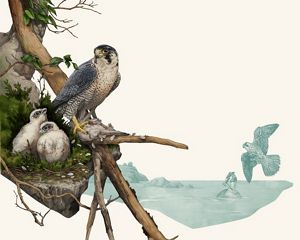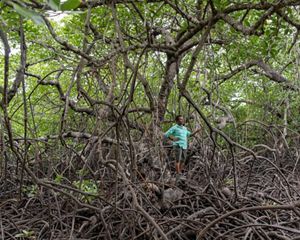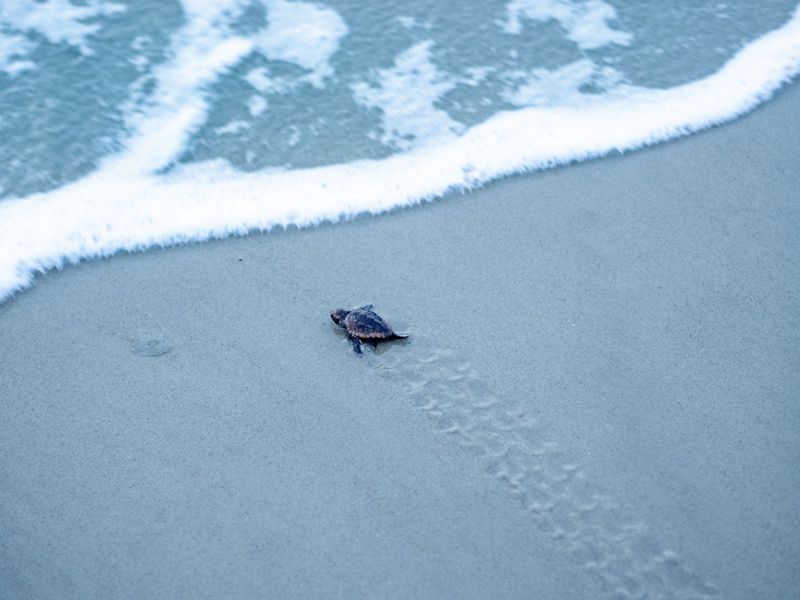
Away We Go A loggerhead hatchling, just moments before its first time in the ocean. © Donna Garcia
The four-wheeler speeds down the deserted beach. It’s about 9:30 p.m. on a nearly moonless July night on the island of Wassaw—a 3-mile-wide piece of land 14 miles southeast of Savannah, Georgia. From the driver’s seat, Kris Williams Carroll scans the area ahead that’s lit through red filters on the Kawasaki’s headlights. She’s looking for trails in the sand, evidence of sea turtles.
“It’ll look like tire tracks,” she says over the engine’s hum. “You can’t miss them.”
They don’t take long to spot: 3-foot-wide parallel grooves running up from the ocean. She cuts the engine. “Wait here,” she tells the three volunteer assistants in the vehicle. Williams Carroll turns toward the sand dunes, and the glow of her red headlamp disappears into the dark. (The red lights disturb sea turtles less than white lights might.) Two minutes later she returns. “She’s still digging. We’ll approach very quietly.”
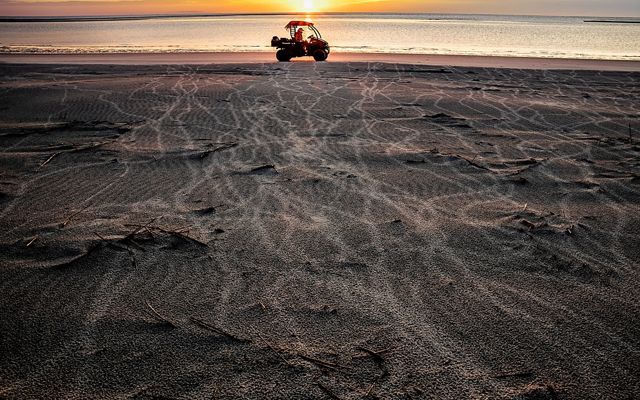

The assistants—all volunteers who pay to be here for a week during the summer—grab their gear and silently head toward a massive dark lump in the sand. The loggerhead sea turtle—a species considered threatened worldwide—is rhythmically moving her flippers, reaching one back flipper at a time below her and flicking a bit of sand away from the hole she’s digging. The group waits for the loggerhead to begin laying her eggs. Once she does, they’ll get to work.
Williams Carroll is the director of the Caretta Research Project, a sea turtle-monitoring nonprofit. The organization began tracking sea turtle nesting on Wassaw in 1973, four years after the family that had owned the island since 1866 sold most of it to The Nature Conservancy for $1 million. TNC in turn sold it for one dollar to the Department of the Interior. Today it’s a national wildlife refuge.
Loggerhead Conservation Takes Decades
Each summer here and all along the Georgia coast, loggerhead sea turtles—and occasionally rarer endangered green sea turtles—lay their eggs on the state’s barrier islands and then return to the ocean. About two months later, baby sea turtles emerge from the nests and crawl to the sea. At best, the hatchlings face 1,000-to-1 odds against surviving to adulthood. And the female turtles that do survive won’t be seen on a beach in this region to lay their own eggs for perhaps another 30 years.
In 2022, Georgia counted a record 4,071 nests laid along its coastline—an incredible 11-fold increase from a low 18 years earlier. Because it takes a quarter century or more for a sea turtle to reach sexual maturity, the numbers seen now are the result of decisions made decades ago. The loggerheads were legally protected as a threatened species under the Endangered Species Act in 1978. Changes in nest management in the 1980s resulted in fewer eggs being eaten by predators like coyotes or raccoons. And special modifications on shrimping nets developed in the 1970s and 1980s reduced the number of sea turtles getting caught in the nets.
Sea Turtle Timeline
A quick estimate on the lifecycle of a loggerhead sea turtle on the Georgia coastline
-
Day 1
Adult female lays eggs and returns to ocean
-
Day 60
Baby turtles emerge after about two months and crawl to sea
-
Year 30
Adult females, around 25-35 years old, come ashore to nest
But those changes wouldn’t have helped if the turtles hadn’t had nesting space to return to. For more than 50 years, land conservation along the coast has maintained reliable nesting habitat for the sea turtles. The region is home to some of the oldest sea turtle-monitoring projects in the world—dating to the 1960s on Little Cumberland Island and 1970s on Wassaw.
Today the sea turtles still face some predation and boat strikes, and those beaches—though protected—are eroding, making them more susceptible to sea-level rise and rough storms. But the growth of the loggerhead population strikes a note of hope for many of the researchers involved. If they can further stabilize the population at the highs it reached mid-century, perhaps the sea turtles can weather whatever future lies ahead.
“Conservation needs to be enduring,” says Christi Lambert, TNC’s director of coastal and marine conservation in Georgia. “We’re in it for the long haul.”
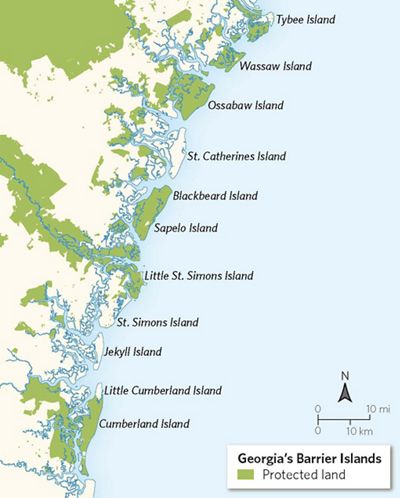
A Sea Turtle Nesting Paradise
The night on Wassaw began at about 8 p.m. as the six volunteers and one intern loaded up two four-wheelers and got their assignments: Half would travel to the north beach and half to the south. Williams Carroll led the south crew, driving through maritime forests of slash pine and live oak that sparkled with fireflies. Low cabbage palm fronds slapped the sides of the vehicle as it made its way to the beach.
“My first night, going through here, I wondered what I had gotten myself into,” says volunteer Bre Adkins, a former schoolteacher and current stay-at-home mom. Williams Carroll laughs. “Some people have told me it feels like they’ve been dropped into Jurassic Park,” she says.
Sea turtles rely on undisturbed dark sandy beaches and dunes for nesting. But the scale of the conservation that has helped provide the turtles space to nest here goes far beyond the beach. Arriving on Wassaw Island—you can only travel there by boat—you wind through the tidal creeks that part the soft green marshes of Wassaw National Wildlife Refuge. In the summer, painted buntings, Wilson’s plovers, black skimmers and other songbirds call the refuge home. American alligators lounge in freshwater ponds. Juvenile sea turtles forage just offshore. It’s a far cry from many of the shores along the southeastern U.S., where high-rise hotels and condominiums glow throughout the night. On Wassaw’s beaches, the only sound is the roar of the wind and waves, and the only light comes from the moon and the stars.
The Georgia coastline—105 miles long—is lined with 14 barrier islands, many of which are still wild. After the Civil War ended in 1865, wealthy Northerners bought many of these islands and constructed Gilded Age winter retreats on them. For decades, the Rockefellers, the Carnegies, even J.P. Morgan himself retreated to rustic family compounds on the islands. A few generations later, after World War II, some family descendants began to sell off the land. Spurred by 1950s-era construction projects at Hilton Head in South Carolina and Georgia’s own Jekyll Island, conservation-minded landowners turned to wildlife agencies and environmental groups. A series of conservation land deals and easements—several involving the then-nascent TNC—followed in the next two decades.
“We identified these areas as priorities many years ago, and we continue to view them as priorities,” says TNC’s Lambert. “It’s that combination of habitat and the management of the habitat and the science—the monitoring—to follow and to learn about and to help these [sea turtle] populations.”
Today only four of Georgia’s 14 barrier islands are accessible by bridge. The U.S. Fish and Wildlife Service manages multiple islands as wildlife refuges. The National Park Service manages Cumberland Island—and its 18 miles of undeveloped beaches—as a national seashore. Each year more sea turtles nest on its dark, deserted sandy beaches than anywhere else in Georgia.
Quote: Christi Lambert
Conservation needs to be enduring. We’re in it for the long haul.
A Future for Loggerhead Sea Turtles
An hour before midnight on Wassaw, the team of volunteers finds another loggerhead laying her eggs. She has metal tags with an engraved code on her front flippers as well as a “PIT tag”—a microchip—that show she has nested on Wassaw before. Her name is Esperanza. (She’s one of the project’s “adopt-a-turtle” subjects.) The team has a relatively short amount of time to work before she finishes laying her eggs and begins to cover her nest in sand. They have a lot to do.
One volunteer—18-year-old Spencer Haltom—begins measuring the length and width of the turtle’s carapace, or top shell. Bre Adkins calculates the location of the sea turtle’s nest away from the shore and the geographic coordinates of this specific spot. Williams takes three biopsies from the turtle’s front flippers. Haltom’s mother, Allison—a veteran volunteer here for her seventh season—grabs an egg from beneath the turtle and places it in a plastic Ziploc bag. The egg will be processed back at the team’s inland cabin, and genetic material from it will be saved in a test tube.
Williams Carroll disappears into the dunes to dig a new hole for these eggs: Esperanza laid her nest in the “wrack line”—the high-water line of debris that washes up on shore. If the nest isn’t moved, it will flood at high tide and the eggs will drown. Up to half of Wassaw’s nests are moved like this, a possible indication of the erosion even this protected beach suffers.
All of these efforts to better understand the loggerhead sea turtle population that nests from here through North Carolina—a population considered genetically distinct from Florida’s—have been built in part on the work of a researcher on Little Cumberland Island. Jim Richardson, a now-retired University of Georgia ecologist, first began cataloging nests on the island where his family had a home in 1964.
Two years later, nest monitoring began on Blackbeard Island, followed by Jekyll Island in 1972 and then Wassaw in 1973. In 1989, the state’s Department of Natural Resources (DNR) began collecting the data statewide, and the Georgia Sea Turtle Cooperative was born.
Loggerhead Sea Turtle Recovery Timeline
-
1978
Listed as Protected under the U.S. Endangered Species Act
-
2004
GA counts a record-low number of loggerhead nests
-
2022
GA counts 4,071 nests, 11 times higher than the 2004 low
Today the cooperative monitors 13 beaches along the coast. Sea turtle technicians with DNR permits patrol the beaches each morning before the tide washes away evidence of sea turtle tracks. They mark nests, removing a single egg from the clutch for the genetics project, and then cover nests with a grate that has holes large enough for hatchings to crawl out but narrow enough to prevent predators from looting the nest. When the hatchlings emerge from the nests later in the season, technicians count the hatched and unhatched eggs and the number of dead hatchlings to document nest mortality.
“Occasionally there’ll be a few—I refer to them as the Lost Boys—who don’t make it out with the rest of the group,” says Russell Regnery, who has a home on Little Cumberland Island and now runs the sea turtle-tracking efforts on behalf of the homeowners there. “You’ll be digging the nest up and counting the eggshells and suddenly you’ll get a little turtle in your hand and then you send it on its way, too.”
Dodd says the long-term nesting data combined with Shamblin’s genetic research has allowed scientists to construct a population model for loggerheads. For now, it’s expected that the population will hold steady. After growing 3.8% each year for the last decade, the population will likely stagnate, Dodd says, reflecting the slow growth of the population in the early 2000s that will soon be reaching maturity. “Then ultimately, maybe in 2040, we expect the population to start increasing back toward historic levels from the late 1950s.”
In the dunes on Wassaw, lit by her red headlamp light, Williams Carroll is using a giant heart cockle shell to dig a new hole for Esperanza’s clutch, her arm buried deep in the sand. “It’s the best thing for it,” she says of the shell. The hole, if cut in a cross section, will look roughly like a misshapen upside-down lightbulb. Williams and the team will ultimately move up to half of the nests laid on Wassaw to safer areas farther inland to keep them from drowning at high tide.
Williams Carroll, who first came to the Caretta Research Project in 1996, remembers stargazing from a military fort on the north beach that dates to the Spanish-American War. Today the fort is in the ocean. The beach there is studded by dead trees—not unlike the famous Driftwood Beach on Jekyll Island—where soil erosion has allowed salt water to inundate the roots of the old forest, killing the trees where they stand. The wider, sandier south beach—where Esperanza laid her nest—tends to host more nests.
The Georgia coastline, lined with 368,000 acres of salt marshes, is ever changing. Rivers run down from the middle of the state, some of them carrying sediment that’s deposited on the islands. When those rivers are healthy, they create an ecological balance: The ocean washes away the islands and the alluvial rivers build them up.
Nowhere is this more visible than about halfway down the coastline on Little St. Simons Island, where its northern beach is growing at a rate of 2 to 3 feet per year—a boon for the sea turtles that come to nest here and a rarity along the coastline. The 11,000-acre, largely undeveloped landscape sits at the mouth of the Altamaha River—a river TNC’s Christi Lambert calls “Georgia’s little Amazon.” At times the river can stretch 6 miles wide, flooding freshwater tidal forests, the water brown with the earth it carries.
Down the coast this year, Lambert helped the homeowners of privately owned Little Cumberland Island construct a “living shoreline”—reinforcing shores and dunes with natural materials like sand or vegetation. There are 10 more completed installations she can name off the top of her head, a string of projects designed to test natural ways to slow coastal erosion caused by storms and sea-level rise.
“It’s important now,” Lambert says, “to work with climate-change predictions and modeling and manage the coast for that—to recognize that in addition to a changing climate and the threats coming from that, we have an increase in people using these beaches, too.”
On Wassaw, Esperanza has returned to the sea. And, just after midnight, the crew spots another turtle. As she lays her eggs, locked in a trance, the volunteers complete their work and then sit beside her, taking the moment in. One front flipper bears a metal tag marked “KKU798.” She’s been here before.
The sand glints on the sea turtle’s carapace, and one of the volunteers shuts off her red headlamp. In the dark, a wave of iridescence sparkles on the turtle’s shell. “Look at the fluorescence,” says volunteer Amelia Gleaton Luke, a former high school science teacher. Among the barnacles on her back, KKU798 is carrying tiny bioluminescent creatures on her journey.
KKU798 eventually lumbers toward the sea, where an otherworldly glow shimmers along the edges of the waves. More fluorescence. Once she’s done nesting—sea turtles sometimes nest repeatedly in a single season—she’ll likely head off to the Chesapeake Bay area peninsula, Williams Carroll says. Satellite transmitters the program attached to a couple of sea turtles this year indicate the reptiles are moving up that way. “There’s great feeding grounds there,” she says. Eventually, the transmitters and past research have shown, this sea turtle will likely return to a beach along this coastline to nest again in two or three years.
Williams Carroll could soon start seeing the nests of some of the turtles that hatched in 1996, her first season on Wassaw. She seems to not have dwelled on that idea much till now. “It’s a neat thought,” she says. “But everything we’re seeing here now is the result of people before us: we’re seeing the results of their labor.”
It’s a sentiment shared by Mark Dodd. “At one point we were very concerned that we were losing loggerheads as a species in Georgia,” he says. “We stand on the shoulders of all these folks who were here in the ’60s and ’70s. It was a lot of hard work to maintain a very high quality of data. We just need to maintain that so we can continue to get those answers that we need to manage the population.”
The moon finally rises around 4 a.m. on Wassaw, and the sun follows not long after. Bug-bitten, sleepy but energized, the week’s crew of volunteers returns to the mainland the next afternoon and off to their daily lives. Two days later the first hatchlings of the season emerge from a nest laid in May. They crawl into the ocean at dawn.
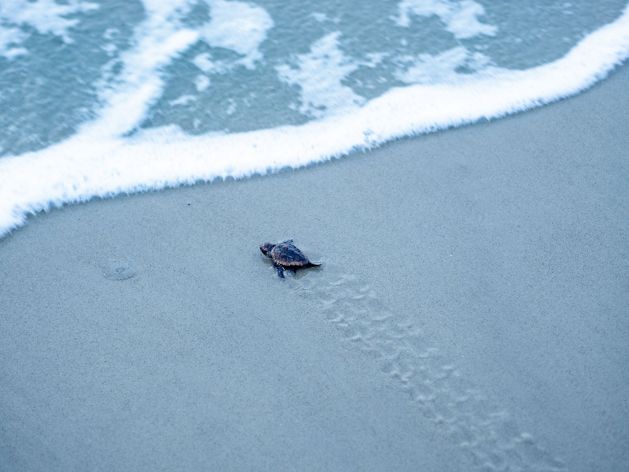
Magazine Stories in Your Inbox
Sign up for the Nature News email and receive conservation stories each month.
About the Creators
Writer: Jenny Rogers is a senior editor and writer for Nature Conservancy magazine, where she’s previously written stories on rare orchids and the Mississippi River.
Photographer: Donna Garcia is a photographic artist and an adjunct professor at the Atlanta Institute of Art. Her work has been featured in galleries from Los Angeles to Budapest.







